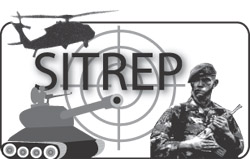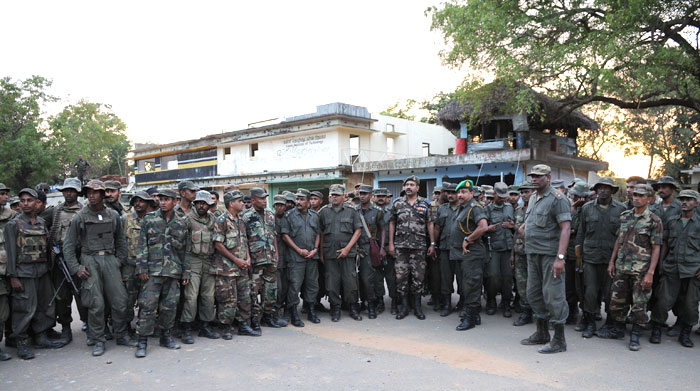End of the road for the LTTE
by Ranil WIJAYAPALA
 If
there is any success story in the war against terror across the globe,
the Sri Lankan Security Forces marked that in the world map with the
dawn of the year 2009 with their unparalleled victories against the LTTE,
the most ruthless terror outfit in the world with the capture of
Paranthan and Kilinochchi. If
there is any success story in the war against terror across the globe,
the Sri Lankan Security Forces marked that in the world map with the
dawn of the year 2009 with their unparalleled victories against the LTTE,
the most ruthless terror outfit in the world with the capture of
Paranthan and Kilinochchi.
They shattered all myths about the invincibility of the LTTE and
their so-called impregnable strongholds, with the capture of their
administrative capital in a surprise move just 24 hours after they
capture the key junction town Paranthan.
These twin victories mark the downfall of the LTTE. Security Forces
could break the backbone of the LTTE and its leader Prabhakaran through
these strategic moves. The national flag fluttered in the open air in
Kilinochchi after ten years as the troops of the 57 Division and the 58
Division trod their feet in the Kilinochchi town in the early hours of
Friday but the official declaration of the capture of Kilinochchi came
in the evening with President addressing the nation to declare victory.
|

LANDMARK MILESTONE: The victorious 58 Div. Commander Brig.
Shavendra Silva(4th from L.) and 57 Div. GOC Major Gen.
Jagath Dias (R. front)with their jubillant troops after
capturing Kilinochchi from the LTTE after 10 years. |
The fall of Paranthan made Kilinochchi untenable for the LTTE as
troops could seal off the town from three directions from the North,
West and the South. It was on the eve of December 31 the troops of the
Task Force I or the 58 Division recorded their historic victory
capturing the key junction town Paranthan. It was after fierce battles
the Task Force I or the 58 Division and the 57 Divisions reached these
victories. Fierce battles erupted in December in the outskirts of
Kilinochchi and Paranthan amidst floods that played havoc in the
battlefront for past one and half months after the capture of Pooneryn.
The initial success of the battles to capture Paranthan and Kilinochchi
came on December 16 as 57 Division and the 58 Division launched
simultaneous attacks on the LTTE’s ditch cum bund that has been
constructed defending these two strategic towns from the West of A-9
road.
That was the final barrier that has to be overcome by the troops to
reach either Paranthan or Kilinochchi. Paranthan was the key target of
the 58 Division under the command of Brigadier Shavendra Silva which
captured strategically important Pooneryn town on the Western coast on
November 15, whilst Kilinochchi was the key target of the 57 Division
under the command of Major General Jagath Dias.
With the capture of Pooneryn the 58 Division diverted its battlefront
from West to East to advance towards Paranthan and confronted heavily
with the LTTE in the ditch cum bund along with the 57 Division which was
on the Kilinochchi front.
Although a fair number of casualties and deaths were reported from
the Security Forces during the fierce battles in the 57 and 58 Division
fronts, the 58 Division troops managed to capture one Kiliometre stretch
of earth bund from the North of Pooneryn Paranthan B-69 Road.The 57
Division also managed to capture a section of the earth bund but had to
give up due to heavy casualties during the counter attack of the LTTE.
The bad weather and the flooded terrains made them difficult to operate
in the earth bund as they faced difficulties in casualty
evacuation.However, the 58 Division managed to hold the ground facing
all counter attacks by the LTTE, and advanced ahead of it from the
Jaffna lagoon front whilst taking the control of the lagoon front and
expanding their positions along the earth bund from Jaffna lagoon
towards south to the Pooneryn-Paranthan Road.They could do so amidst
stiff resistance from the LTTE and also amidst rains of artillery and
mortars falling to the battlefront. The Tigers were using fresh stocks
of ammunition unloaded from a ship operating in the international waters
close to Sri Lanka.
The initial success of the Paranthan battle came when 58 Division
troops managed to capture Sinnaparanthan located some five to six
kilometres from the West of Paranthan junction. Amidst all resistance by
the LTTE, the 58 Division managed to link up their positions along the
earth bund from Jaffna lagoon to Pooneryn Paranthan front and continued
to expand towards the South of Pooneryn-Paranthan Road towards Adampan
village.
Whilst 58 Division was making these moves the 57 Division also
following the massive attack they launched on the Tiger earth bund on
December 20, recaptured the ditch cum earth bund from West and South of
Kilinochchi making a steady progress against the LTTE in the Kilinochchi
front advancing towards Kilinochchi from the West and South
directions.By December 30 the 58 Division had created the ground work to
capture either Paranthan or Pooneryn townships as they were closing in
onto the A-9 Road from both directions. But Army Commander Lt. General
Sarath Fonseka decided to give priority for the capture of Paranthan
considering the tactical importance of the location. The fall of
Paranthan also herald the downfall of Kilinochchi and also the Jaffna
front as they could cut vital arteries that link Kilinochchi and Jaffna
front through Paranthan front.
The capture of Paranthan meant the LTTE losing the vital links
between Jaffna front and Mullaitivu too as they could not operate
through the A-35 Road once the troops capture Paranthan junction and the
stretch of A-9 Road in the North of Paranthan. Instead, they have to use
the coastal link from Chempiyanpattu to Mullaitivu to keep strategic
links between Jaffna front and Mullaitivu which are the remaining
territories under their control. Considering all these factors troops of
the 58 Division decided to launch the offensive to capture Paranthan
whilst maintaining pressure on Kilinochchi as they were operating one
and half kilometres to Kilinochchi from the North.Troops of 58 Division
went on a wider front to Paranthan and cut off A-9 Road from 3 Km North
of Paranthan a location between Paranthan and Elephant Pass whilst
another column of troops cut off the A-9 Road in general area famously
known as Karandi Bokkuwa which is located some four Kilometers South of
Paranthan junction.
The 9 Gemunu Watch battalion under the command of Lt. Colonel Lal
Chandrasiri cut off the A-9 Road from the North of Paranthan whilst
troops attached to the 10 Gajaba Regiment under the command of Major
Udaovita advanced from the South of Pooneryn-Paranthan Road to cut off
the A-9 Road in the general area Karandibokkuwa in the North of
Kilinochchi. The 12 Gemunu Watch battalion commanded by Lt. Colonel
Nandana Dunuwila advanced towards the A-9 from the North of Paranthan
while 17 Gemunu Watch battalion under the command of Lt. Colonel Keerthi
Kottewatta advanced head on to the Paranthan junction in their bid to
capture the key junction town. Since it was totally difficult task for
the infantry troops to cross the open terrain stretching more than one
and half kilometres to advance towards A-9, 58 Division troops used the
30th night and the 31st morning before the first morning light to bring
in troops as close as 500 meters to the West of A-9 Road in the West of
Paranthan.On December 31 morning without taking much casualties they
took the area West of Paranthan junction.
The Commando troops led the battle operating ahead of the infantry
troops and were supported by the artillery and armoured corps taking the
Tiger positions accurately. The fighter jets and the MI-24 helicopter
gunships of the Sri Lanka Air Force gave close support to the ground
troops in neutralizing LTTE artillery and mortar positions.With the
capture of the Paranthan junction the troops of the 58 Division started
to expand their front further towards Kilinochchi to the South.Troops
attached to 10 Gajaba Regiment under the Command of Major Udaowita and
11 Sri Lanka Light Infantry battalion under the command of Lt. Colonel
Kithsiri Ekanayake advanced towards Kilinochchi from the East of A-9
Road whilst troops attached to 12 Gajaba Regiment under the command of
Major Saliya Amunugama and 6 Gemunu Watch battalion under the command of
Lt. Colonel Kamal Pinnawala advanced towards Kilinochchi town from the
West of A-9 road.Whilst the 58 Division making these strategic moves the
57 Division under the command of Major General Jagath Dias also led his
troops in the West and South of Kilinochchi towards the centre. The 571
Brigade under the command of Lt. Colonel Harendra Ranasinghe advanced
towards Kilinochchi from the West whilst keeping links with 8 Gemunu
Watch Battalion under the command of Lt. Colonel Vajira Welagedara who
was operating in the Southern end of the 58 Division.
By December 3, the 571 Brigade operating in the West and the 572
Brigade under the command of Lt. Colonel Dhammika Jayasundera operating
in the South West of Kilinochchi have already reached the build up area
of Kilinochchi town West of A-9 road. The 574 Brigade under the command
of Lt. Colonel Senaka Wijesuriya also advanced towards the vital
Iranamadu junction from South of Kilinochchi amidst stiff resistance
from the LTTE. As of January 01, the troops observed a remarkable
progress as they observed LTTE cadres fleeing from the Kilinochchi town
loading their stuff in vehicles whilst their leadership was making
desperate attempts to stop them fleeing Kilinochchi.
At the dawn of the January 2, troops of the 572 Brigade, 12 Sinha
Regiment which was under the command of Lt. Colonel Indrajith Bandara
and now led by its second in command, 9 Gajaba Regiment under the
command of Lt. Colonel Chandana Somaweera, and 4 Sinha Regiment entered
the centre of Kilinochchi after advancing one kilometre across the build
up area in the West of Kilinochchi.
The 3 Gajaba Regiment and the 9 Vijayaba Infantry regiment under the
572 Brigade entered the Kilinochchi town from the North of Iranamadu
junction. The 8 Sri Lanka Infantry Regiment under the command of Lt.
Colonel Epsitha Dissanayake, 10 Sri Lanka Light Infantry battalion under
the command of Major Samantha and 16 Sinha Regiment battalion under the
command of Major Dhammika Dissanayake took control of the area upto the
telecom tower in the South of Kilinochchi.
Amidst these moves LTTE opted to flee from Kilinochchi from the
eastern direction towards Dry Aru. Fierce battles erupted in Dry Aru
tank area and Iranamadu tank as troops further advanced towards the East
of Kilinochchi town to make the town more safer.One major obstacle they
faced was the 30 mm canon famously known as pedal gun of the LTTE that
directed fire at the advancing troops who shifted that gun from the area
by Friday afternoon to ensure the area is safe to declare Kilinochchi
fully liberated.
With the capture of Kilinochchi and Paranthan troops are now poised
to advance further in the Eastern direction to capture strategic
Puthukuduiruppu and Vishvamadu areas. |

